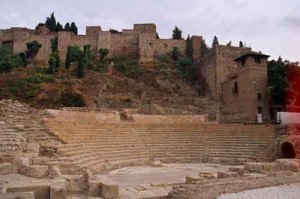The Alcazaba is a very well preserved Moorish fortification dating from the 8th century, although much of it was built around the middle of the 11th century for King Badis of Granada, serving as the palace of the governors of the city.
Next to the entrance to the Alcazaba are the ruins of a Roman amphitheatre dating from the 2nd century and some of the Roman materials were used in the construction of the Alcazaba.
The Alcazaba sits on a hill in the centre of the city, overlooking the port, and comprises two walled enclosures. It was originally connected to the city ramparts to form a third defensive wall but only the two inner walls remain.
The first wall, built around the topography of the hill, completely encloses the second inner area and contains numerous defensive towers. The entrance is through the ‘Puerta de la Bóveda’ and the entrance gate doubles back on itself, a design intended to make progress difficult for attacking forces.
The pathway winds up through landscaped gardens containing a number of ornate fountains, passing the ‘Puerta de las Columnas’ (Column Gate) and the ‘Torre del Cristo’ (Christ’s Tower). This last tower turns at right angles, another attempt to impede the progress of attackers. The ‘Torre del Cristo’, which reuses materials from the Roman ruins, once also served as a chapel.
The inner enclosure is reached through the ‘Puerta de los Cuartos de Granada’ (Gate of the Granada Quarters) which acts as the defense to the western side of the palace. On the eastern side is the ‘Torre del Homenaje’ (Tribute Tower).
Inside the second wall is the Palace and other buildings which were built during the 11th, 13th and 14th centuries and includes the ‘Cuartos de Granada’ (Granada Quarters), the home of the former ruling governors. The inner enclosure also houses the Archaeological Museum.
After a long siege, Málaga city was captured by Ferdinand and Isabella in 1487 and they raised their standard on the ‘Torre del Homenaje’ in the inner citadel.

